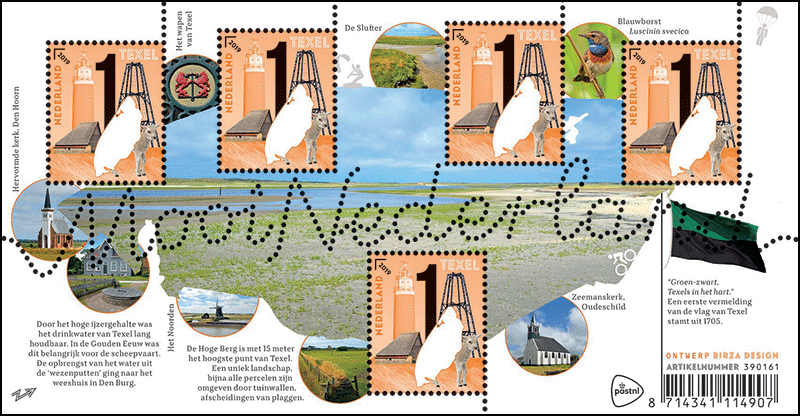By John M. Hotchner
What do you see when you receive a stamp on an envelope or at a post office? The average user of the mails might notice a bit of color; maybe even the subject or design, but by 20 minutes later most could not tell you what the design illustrated.
 Stamp collectors are different. We look at the stamp, classify it according to whether it is a common variety or something more interesting, and decide whether to keep it. And perhaps at the subconscious level, we also evaluate modern stamps in the context of what has gone before — and for many of us, the comparison is often not positive.
Stamp collectors are different. We look at the stamp, classify it according to whether it is a common variety or something more interesting, and decide whether to keep it. And perhaps at the subconscious level, we also evaluate modern stamps in the context of what has gone before — and for many of us, the comparison is often not positive.
For most people, stamps are a means to an end. For collectors, they can be that, but most importantly, they are an end in themselves. So, what is it that collectors find attractive and unattractive about these objects of our affection? At the most obvious level, which the non-collector also sees but may not appreciate, there are ten factors:
a. Color either monocolor or multicolor. Most of today’s stamps are a mix of colors because the general public has voted for this with their wallets. They find multicolor more pleasing and attractive, regardless of what the colors may be. Collectors tend to notice the colors used, and make judgments about the attractiveness, the appropriateness, and the arrangement of the colors.
b. Print Quality, Part I For collectors, especially those of the old school, the Gold Standard is single color that has been printed by recess engraving. We find these examples of the engraver’s and printer’s art near irresistible. Unfortunately, they are more expensive to produce and have become a victim of the Postal Service’s bean counters. The USPS budgeting process values cost avoidance before all else; second, revenue, and then in third place they may evaluate how customer preference might intersect with the other two. They see collectors more as cash cows to be milked than as a constituency to be pleased (though I don’t think the Citizens’ Stamp Advisory Committee totally buys into that), so we don’t see many recess engraved stamps among the new issues of the United States. Of the majority, whether we can identify them or not, we tend to react better to photogravure printing than offset.
 c. Print Quality, Part II Advances in printing technology have over the years since our first postage stamps in 1847, improved the uniformity and the quality of stamps coming off the presses. It used to be that a collector could make their life’s work the study of a single stamp in all its varieties. On most of today’s stamps, it is a struggle to find an example that differs in any significant way from all its brothers and sisters.
c. Print Quality, Part II Advances in printing technology have over the years since our first postage stamps in 1847, improved the uniformity and the quality of stamps coming off the presses. It used to be that a collector could make their life’s work the study of a single stamp in all its varieties. On most of today’s stamps, it is a struggle to find an example that differs in any significant way from all its brothers and sisters.
d. The Topic/Subject may be the first thing we all consciously notice and react to. For the general public, it may be the only criterion for what to buy, while collectors have more subtle and more complicated reactions. All buyers/viewers like a pretty flower stamp. But for the general public, that is where it ends. For collectors, a little of that (puppies, lighthouses, birds, costumes, etc.) goes a long way. We prefer topics with some gravitas: history illustrated though events and the people who excelled in their fields and contributed to making America great, events that advance the human condition like space stamps, scientific discoveries and medical advances.
e. The Design is of little importance to the general public, but of supreme importance to collectors. The Postal Service has two responsibilities here: First, to convey the subject clearly on a small palette, and second, to reflect the full range of American art styles in its stamps. That includes, among others, abstract art, comic art, impressionism, pop art and photography. But a large percentage of collectors are traditionalists; not fond of anything not, well, traditional. So, collectors have a full range of thoughts and feelings on the art used for any given subject. While cocktail parties talk Trump, stamp club meetings talk stamp design trends, especially as represented on new issues.
f. The Size which is always “the bigger the better” unless you are the public, having to carry around giant Priority Mail, Express Mail or large commemorative stamps. Now, the reality is that the extra weight and size of large commemoratives is hardly worth considering, but the general public has its concerns and this is undeniably one of them. Collectors on the other hand generally revel in ‘bigger is better’ when contemplating stamps they liked, but will immediately jump to critic mode when the stamp is a large version of something they don’t like.
g. Stamp Shape which draws the same kinds of complaints when non-traditional circular, especially tall or wide, or triangular stamps are issued. The USPS sees these as interesting variations on what might otherwise be a boring theme, and believes they bait the stamp collecting hook (of which more later), but collector reaction is by and large not complimentary.
h. Stamps In Souvenir Sheets clearly intended by the USPS not for postal use but for collectors. Few such sheets are used on mail, but then, it requires real effort to remove the postage from the excess paper for use. So, while many collectors enjoy them as philatelic souvenirs, the same collectors may be annoyed, feeling that they are being fleeced.
i. Face Value has risen with inflation, and has risen even faster if Priority Mail, Express Mail and souvenir sheets are counted in. The public buys what they need and it is fee for service. But it requires a real act of will for a collector to lay out over $80 for a new Express Mail plate block (every 18 months or so), and in this way, the USPS is pricing itself out of the market as the vast majority of stamp collectors are not in that league.
j. Multi-Stamp Sets combined with face value, make even relatively inexpensive stamps an investment when there are 10 or 20 different pets, Harry Potter characters, Peanuts Christmas stamps, etc. It used to be this was limited to commemorative subjects, but in recent years the Postal Service has extended it into the domain of definitives. All of this tends to encourage stamp collectors to avoid mint stamps, and to concentrate on used. (But even this is more difficult to swing now that most self-sticks can’t be washed.)
At the second level are the technical details of the stamp. These are almost totally ignored by the general public if they are noticed at all. Again there are multiple aspects:
a. The Paper Used, And Its Color which can be bright to dull, thin to thick, coated or not, and pregummed or gummed after printing. In the olden says, there was also the issue of watermarks.
b. The Tagging which can be in the paper, on top of the paper, overall or block, and can fluoresce in many colors.
c. The Gum which can be flat or shiny, ridged or not, and self-stick (with the consequent problems of aging and nonwashability). On this one there is a sharp split between collectors and non-collectors. The latter generally love self-sticks. Collectors are ok with them if used stamps can be washed from envelops, but unalterably opposed, with flashes of anger, if they don’t wash.
d. The Means Of Separation which used to be simple perforations (holes between the stamps), but has now moved on to die cuts of various shapes and sizes often with several variations on the stamps of a single issue.
e. Added Factors such as plate numbers and what they represent, the copyright or issue date, secret marks to deter counterfeiting (often in the form of microprinting, or opticalvariable devices), and backing paper which is now an integral part of collecting a “mint” stamp.
Collectors may ignore or study the multiple variations in each of these second level categories.
At the third level; some of which are obvious even to the non-collector, and many of which are not, are unintended production varieties. These are often termed in philately EFOs, for Errors, Freaks and Oddities. Each of these is a term of art that has a lengthy definition, and if you want to learn more about this area, visit www.efocc.org, the website of the EFO Collectors Club.
To the extent that the general public cares about these at all, it is because they have found something really obvious like a missing color, or unintended imperfs. Sometimes they will turn these back into the post office, saying something like, “Take these back and give me good ones that I can use.” For the more philatelically aware, the immediate question is how do they turn these into money?
Collectors are more likely to keep EFOs, as even minor examples are relative rarities. The truly dedicated will also use EFOs as a window on the production process; as a means of understanding the fascinating world of stamp printing.
Can we learn anything from this brief review of the properties of a stamp, and the differences in how stamps are seen by collectors and non-collectors?
I think a primary lesson is that the USPS is in a no-win situation. In order to get the attention of non-collectors and to draw them into the hobby, they have to produce an unending stream of stamps with popular themes that the general public will pay attention to, but which dyed-in-the-wool collectors often find annoying and manipulative.
Another is that there is much more to stamps than the general public ever thinks about, and much more for collectors to think about and enjoy than most have time, money or inclination for.
The “old” way of collecting a mint example of every stamp the United States has issued is now a huge challenge (with over 5500 different stamps; many of the earliest examples beyond the ability of our wallets to acquire). So country collecting — even in used-stamps form — is giving way to topical collecting and discreet time period-collecting.
Very little of this is obvious to us as we look at a stamp we buy or receive on an envelope today.
Should you wish to comment on this editorial, or have questions or ideas you would like to have explored in a future column, please write to John Hotchner, VSC Contributor, P.O. Box 1125, Falls Church, VA 22041-0125, or email, putting “VSC” in the subject line.
Or comment right here.
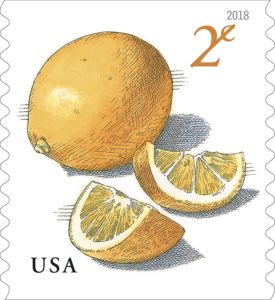 Effective January 27, 2019, the following low denomination coils in the 10k format will also be available in the 3k format:
Effective January 27, 2019, the following low denomination coils in the 10k format will also be available in the 3k format:
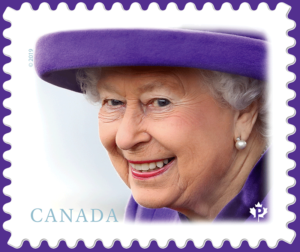 OTTAWA, Jan. 14, 2019 /CNW/ – Canada Post issued a new stamp paying tribute to Her Majesty Queen Elizabeth II, bearing a 2017 photo of the Queen taken in Portsmouth, England, by Chris Jackson. Queen Elizabeth II has appeared on Canadian stamps since the coronation issue was released in May 1953 – and was also featured on several stamps while still a Princess during the reigns of both King George V and King George VI.
OTTAWA, Jan. 14, 2019 /CNW/ – Canada Post issued a new stamp paying tribute to Her Majesty Queen Elizabeth II, bearing a 2017 photo of the Queen taken in Portsmouth, England, by Chris Jackson. Queen Elizabeth II has appeared on Canadian stamps since the coronation issue was released in May 1953 – and was also featured on several stamps while still a Princess during the reigns of both King George V and King George VI.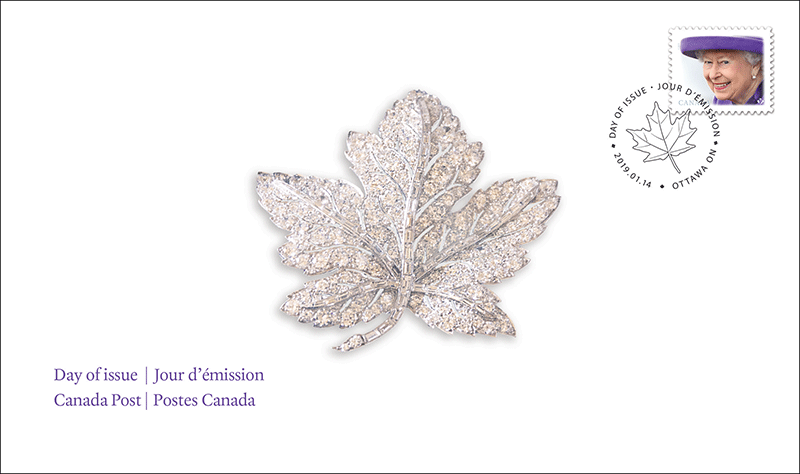

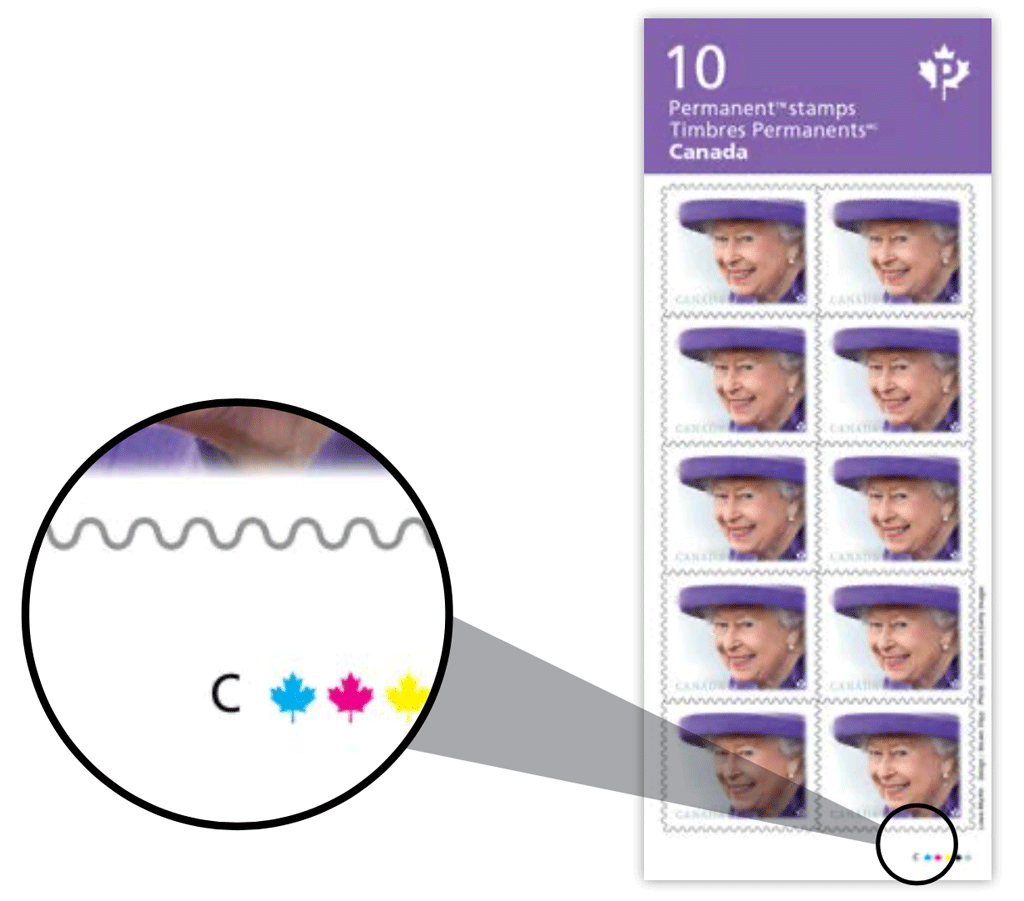 Note that the C is NOT underlined on booklets that DO NOT have the security feature underprint.
Note that the C is NOT underlined on booklets that DO NOT have the security feature underprint.
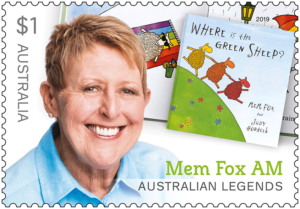 The 2019 legends —
The 2019 legends — 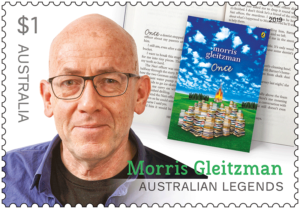 “This year’s recipients are celebrated authors who create impactful stories that children and adolescents love and remember,” Ms Sheffield said.
“This year’s recipients are celebrated authors who create impactful stories that children and adolescents love and remember,” Ms Sheffield said.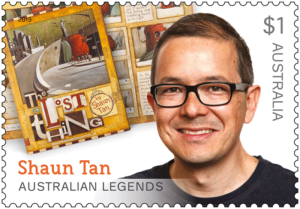 Sheffield.
Sheffield.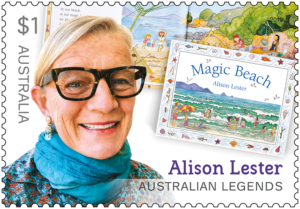 and Bert Newton. A complete list of recipients can be found at auspost.com.au/legends.
and Bert Newton. A complete list of recipients can be found at auspost.com.au/legends.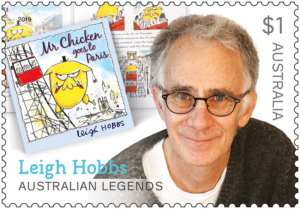 stamps, a first day cover, stamp pack, maxicard set, five booklets of ten $1 stamps, and a booklet collection pack.
stamps, a first day cover, stamp pack, maxicard set, five booklets of ten $1 stamps, and a booklet collection pack. Stamp collectors are different. We look at the stamp, classify it according to whether it is a common variety or something more interesting, and decide whether to keep it. And perhaps at the subconscious level, we also evaluate modern stamps in the context of what has gone before — and for many of us, the comparison is often not positive.
Stamp collectors are different. We look at the stamp, classify it according to whether it is a common variety or something more interesting, and decide whether to keep it. And perhaps at the subconscious level, we also evaluate modern stamps in the context of what has gone before — and for many of us, the comparison is often not positive.
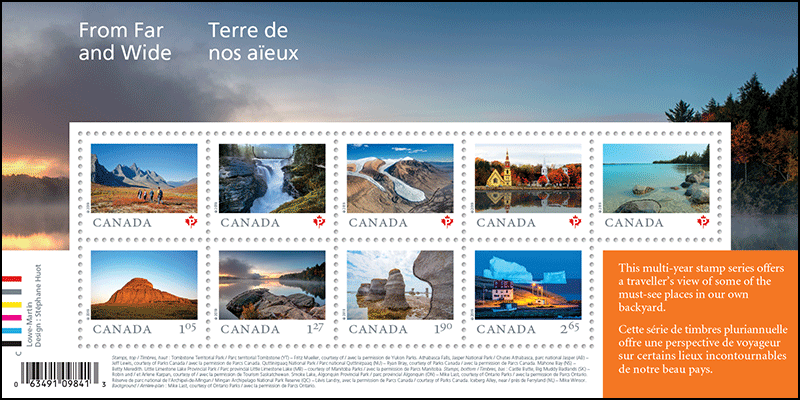 This series continues to invite Canadians to seek out this country’s most picturesque places.
This series continues to invite Canadians to seek out this country’s most picturesque places.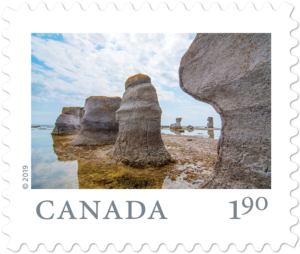 Canada Post has issued the second set of stamps in the multiyear From Far and Wide series – its name inspired by a line in the lyrics of “O Canada” – that promises to take Canadians on an armchair journey to some of the most breathtaking and memorable must-see locations.
Canada Post has issued the second set of stamps in the multiyear From Far and Wide series – its name inspired by a line in the lyrics of “O Canada” – that promises to take Canadians on an armchair journey to some of the most breathtaking and memorable must-see locations.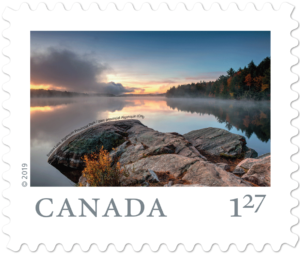 Tombstone Territorial Park, Yukon
Tombstone Territorial Park, Yukon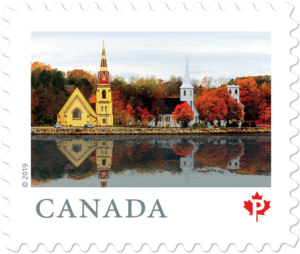 The Permanent domestic stamps are available in booklets of 10 (two of each image) and coils of 100, while the U.S.-rate, Oversized-rate and International-rate denominations are available in booklets of six and coils of 50. The issue also includes a souvenir sheet and several other formats for collectors, as well as an Official First Day Cover, cancelled in Mahone Bay, Nova Scotia, the location featured on one of the Permanent stamps. The issue was designed by Stéphane Huot of Montréal and printed by the Lowe-Martin Group.
The Permanent domestic stamps are available in booklets of 10 (two of each image) and coils of 100, while the U.S.-rate, Oversized-rate and International-rate denominations are available in booklets of six and coils of 50. The issue also includes a souvenir sheet and several other formats for collectors, as well as an Official First Day Cover, cancelled in Mahone Bay, Nova Scotia, the location featured on one of the Permanent stamps. The issue was designed by Stéphane Huot of Montréal and printed by the Lowe-Martin Group.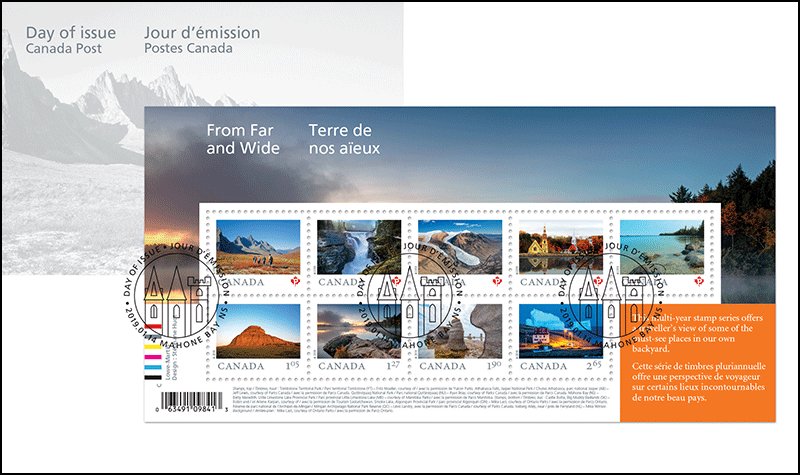
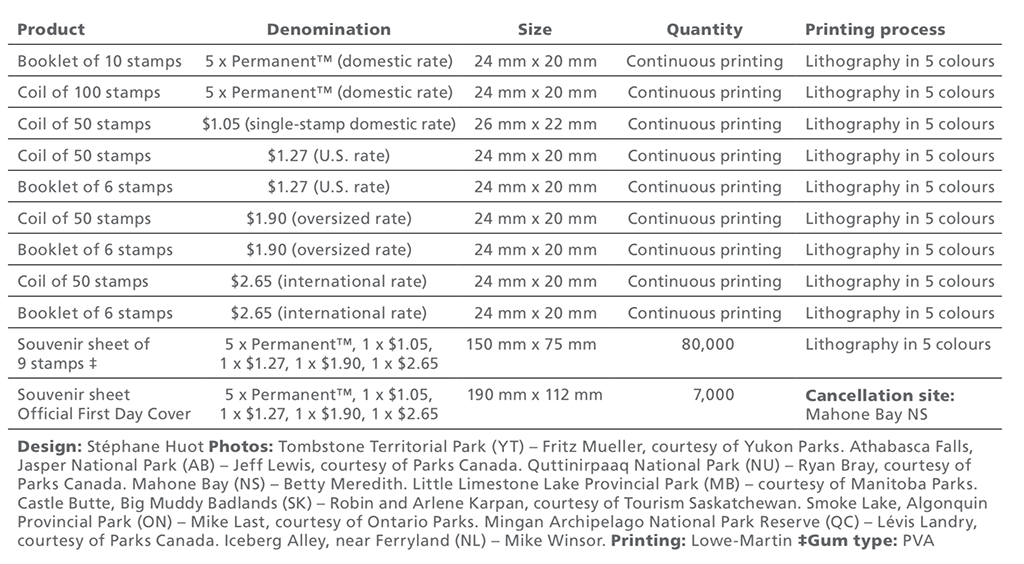

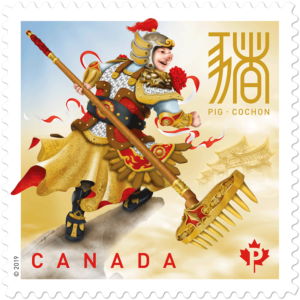 MARKHAM, ON – Canada Post rings in the Lunar New Year with a two-stamp issue on January 18, the 11th in its current 12-year series. In honour of the Year of the Pig, the stamps feature Zhu Bajie, or Pigsy, a character from the celebrated 16th century Chinese novel Journey to the West.
MARKHAM, ON – Canada Post rings in the Lunar New Year with a two-stamp issue on January 18, the 11th in its current 12-year series. In honour of the Year of the Pig, the stamps feature Zhu Bajie, or Pigsy, a character from the celebrated 16th century Chinese novel Journey to the West.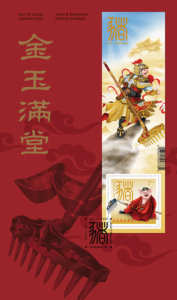 a traditional gummed pane of 25 domestic-rate stamps, featuring four Chinese blessings; and
a traditional gummed pane of 25 domestic-rate stamps, featuring four Chinese blessings; and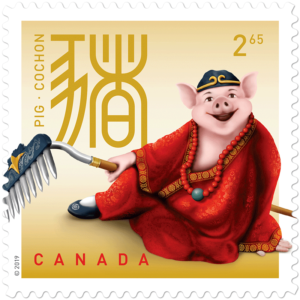
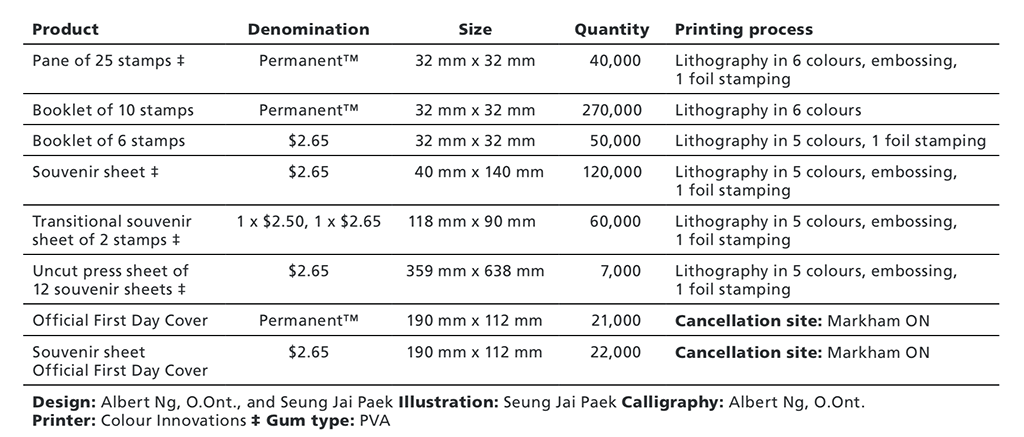
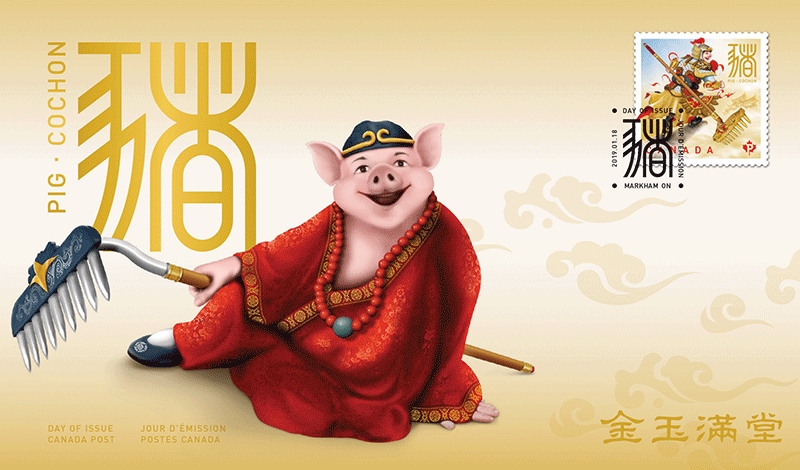
 Updated January 15th
Updated January 15th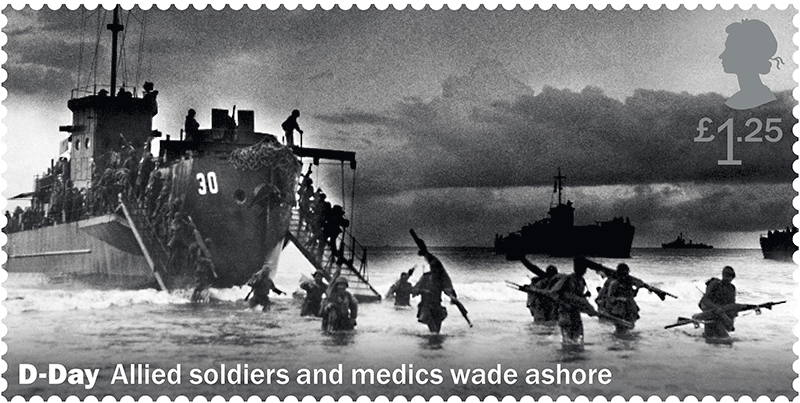 Royal Mail quickly sent out a correction, adding that the stamps had not yet been printed and, of course, this design won’t be printed.
Royal Mail quickly sent out a correction, adding that the stamps had not yet been printed and, of course, this design won’t be printed.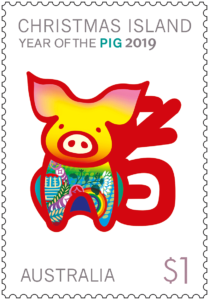 To celebrate the Year of the Pig 2019, Australia Post is releasing two commemorative Lunar New Year stamps – the 12th and final stamp to complete the current Lunar New Year 12-design series.
To celebrate the Year of the Pig 2019, Australia Post is releasing two commemorative Lunar New Year stamps – the 12th and final stamp to complete the current Lunar New Year 12-design series.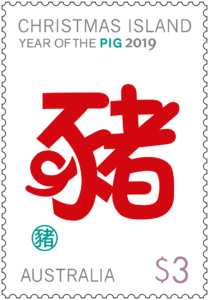 Those born under the Pig sign are known to be kind, patient and empathetic, making them suited to a career as a teacher, doctor, vet or social worker. The Pig’s lucky flower is marigold; lucky colours are yellow, grey, brown and gold; and lucky numbers and 2, 5 and 8.
Those born under the Pig sign are known to be kind, patient and empathetic, making them suited to a career as a teacher, doctor, vet or social worker. The Pig’s lucky flower is marigold; lucky colours are yellow, grey, brown and gold; and lucky numbers and 2, 5 and 8.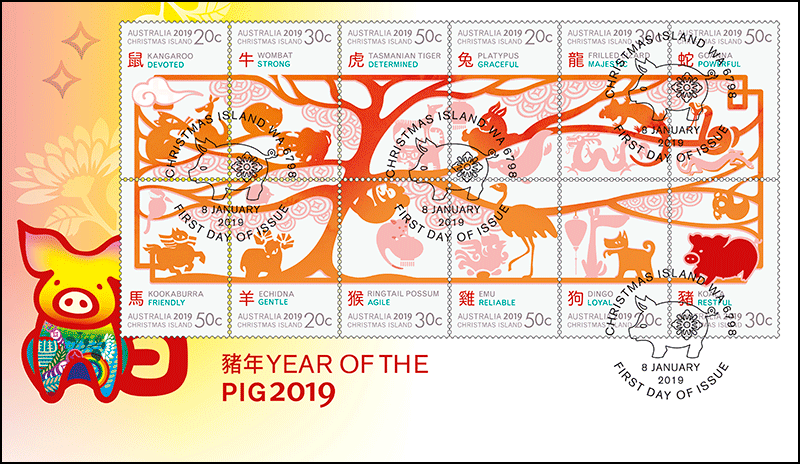 Other products associated with this stamp issue include a first day cover, stamp pack, silk minisheet pack, postcards, international and domestic postage-paid envelopes, Happy New Year postal numismatic cover, Dragon postal numismatic cover, medallion cover, prestige booklet featuring stamps from the zodiac sheetlet, and a Lotus sheetlet pack.
Other products associated with this stamp issue include a first day cover, stamp pack, silk minisheet pack, postcards, international and domestic postage-paid envelopes, Happy New Year postal numismatic cover, Dragon postal numismatic cover, medallion cover, prestige booklet featuring stamps from the zodiac sheetlet, and a Lotus sheetlet pack.